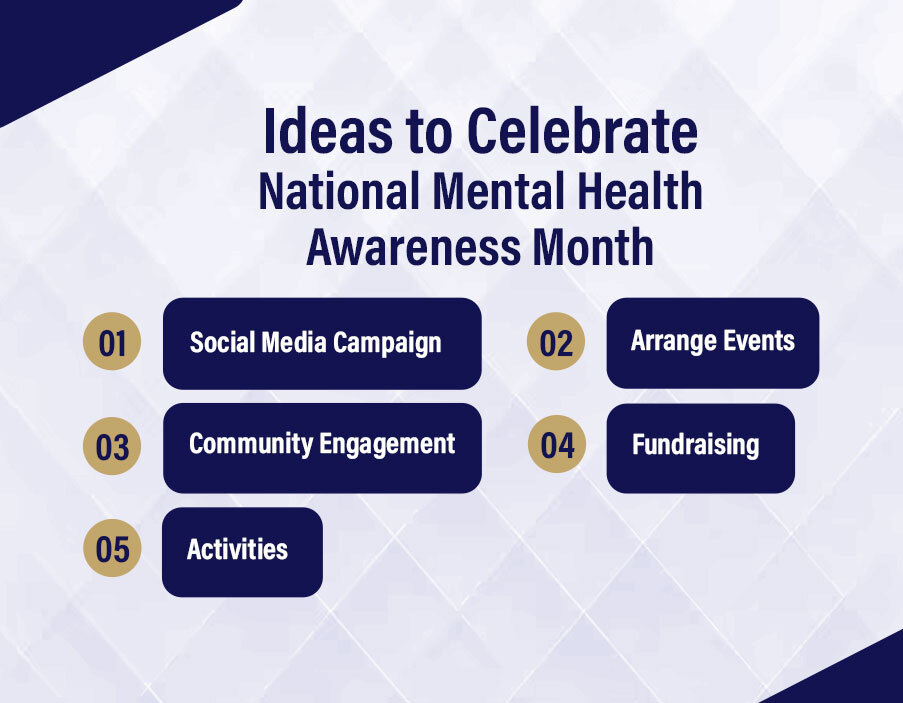May is National mental health awareness month. Starting in 1949, Mental Health Awareness Month worked as a beacon in the fight against the problems that an estimated 55 million Americans struggling with mental health conditions face every day.
During the course of the month, NAMI is joining the national movement to get rid of stigma, create support groups, educate the public and lobby for policies that promote the welfare of people and their families with mental health challenges.
May is a necessary time to raise awareness. This month-long event helps educate, reduce stigma, and raise awareness of mental health concerns.
National Mental Health Awareness Month History
National Mental health awareness month began in the mid-20th century. Mental Health Week was founded in 1949 by Mental Health America (MHA) and the National Association for Mental Health (now NAMI).
The event became Mental Health Month in 1963 to increase awareness and advocacy. This shift allowed for a more comprehensive mental health focus throughout May.
Mental Health Month is in May, which represents spring in the Northern Hemisphere. This season of regeneration and growth reflects mental health awareness’s themes of hope and recovery.
From its beginnings, national mental health awareness Month has expanded. This is a crucial moment for individuals, organizations, and communities to raise awareness and push for better mental health care and support.
Mental Health Facts and Statistics
- 23.1% of U.S. adults aged 18 and above suffer from diagnosed mental health conditions in 2022.
- 6% of the American population suffered from serious mental health disorders in 2022, and that constitutes an impairment of one’s functional ability. Such mental health practices are often psychotic disorders or bipolar disorders or disorders that involve severe eating or anxiety problems.
- The fact is that the existing statistics say much about the situation, 32.9% American adults are considered to have both mental health disorders and substance abuse issues.
- Specifically, 5.2 million veterans have undergone a behavioral condition such as mental illness in 2022 (Million Research Institute, 2022).
- Statistics from 2020 put the U.S. in the second position for children death caused by suicide, only surpassed by children killed because of accidental injury.
- The depression and anxiety that economies worldwide experience come at a cost of $1tr missing out on the productivity potential annually.
- Per an RN Health Study 2021, 51.7% of US women were accessing the mental health services, while in the same study, only 40% of men managed to have mental health services.
- Undoubtedly, mental illness is more frequent among young adults aged 18 to 25 and subsequently adults aged 26 to 49 years as the rate of experiencing any type of mental disorder (33.7%) and the rate of having serious mental illness (11.4%) has increased for these groups.
- Women suffer from the most extreme mental health disorders than men in a ratio of 7.1% to 4.2%.
- The number of adult U.S. residents that are treated for mental health issues increased from 19.2% to 21.6 % in 2021.
Mental Health Statistics
Multiracial adults in the U.S. had the highest rate of mental illness in 2022, at 35.2%. Whites had 24.6% mental illness, Hispanics 21.4%, Blacks 19.7%, American Indian or Alaska Natives 19.6%, and Asians 16.8%. In 2020, 50.2% of LGBTQIA+ persons identified as lesbian, gay, or bisexual (LGB) had a mental health disorder, more than double the rate of heterosexual adults.
Transgender folks had approximately four times the rate of cisgender adults with mental illness. In 2019, 86% of LGBTQ+ youth reported being bullied or abused at school, while just 37% recognized their home as an identity-affirming space in 2022, highlighting their mental health issues. These figures show that LGBTQ+ people are more likely to have mental health issues like sadness and anxiety.
Ideas to Celebrate National Mental Health Awareness Month

Social media campaigns
Arrange Events
Hold mental health workshops, seminars, conferences, or webinars. Ask mental health specialists, guest lecturers, or survivors to offer their knowledge.
Community Engagement
Promote mental health with local organizations, schools, and community centers. Work together on mental health education and support events.
Fundraising
Run campaigns to support mental health charities. Support mental health services, research, and advocacy by donating.
Activities
Offer yoga, mindfulness, art therapy, and nature walks to improve mental wellness. These activities relieve stress, increase mood, and boost mental health.
Advancements in Mental Health Awareness and Care in the United States
The Substance Abuse and Mental Health Services Administration (SAMHSA), other HHS agencies, the Federal Government, the public health community, and the public have spent two decades raising awareness of mental health prevention and treatment. Mental illness patients’ prospects have improved due to these initiatives.
Over time, successful mental health awareness initiatives have promoted acceptance, support, prevention, and recovery. Numerous efforts and laws have advanced mental health care:
- 11 million people needed substance abuse and mental health therapies under the Affordable Care Act, which sought to cover 30 million Americans by 2016.
- States and territories have received funding from the Community Mental Health Services Block Grant to implement comprehensive community-based mental health services and evidence-based practices for adults with serious mental illnesses and children with serious emotional disturbances.
- The 2008 Mental Health Parity and Addiction Equity Act has reduced discrimination in health care and increased access to key mental health and substance use disorder therapies through more fair insurance coverage.
- The Garrett Lee Smith State/Tribal Suicide Prevention Program has helped government agencies and the private sector develop, implement, and evaluate youth suicide prevention and early intervention plans in schools, juvenile justice systems, substance abuse programs, and mental health programs.
Goals Of National Mental Health Awareness Month
Throughout Mental Health Awareness Month, the ultimate goals entail working towards eliminating stigma and encouraging comprehension of mental health disorders which are part of our daily lives.
Moving toward the objective of open conversations on mental wellness will solidify informing and understanding more about this truly important issue. Through the elimination of the stigma, people will be able to ask for assistance where they need it and benefit from an encouraging environment while addressing mental health issues.
Education and making the public aware of mental health issues, how many people are affected, and the type of help that is available to those in need and who want to have treatment.
The whole purpose of national mental health awareness month is to uphold such attitudes where there is more compassion and society is definitely inclusive everywhere. However, mental health is largely valued and there is a feeling of being empowered by all humans to get the care they need in time.
Summary
National Mental Health Awareness Month is an important time to raise awareness and understanding of mental health.. Everyone should prioritize mental health and seek help when required, and this awareness month reminds us.
Join the movement and celebrate the national Mental Health Awareness Month. Share your support on social media, educate others about mental health, and help those in need. We can change society and make it more inclusive and supportive. Share and get engaged to improve everybody’s mental health.

